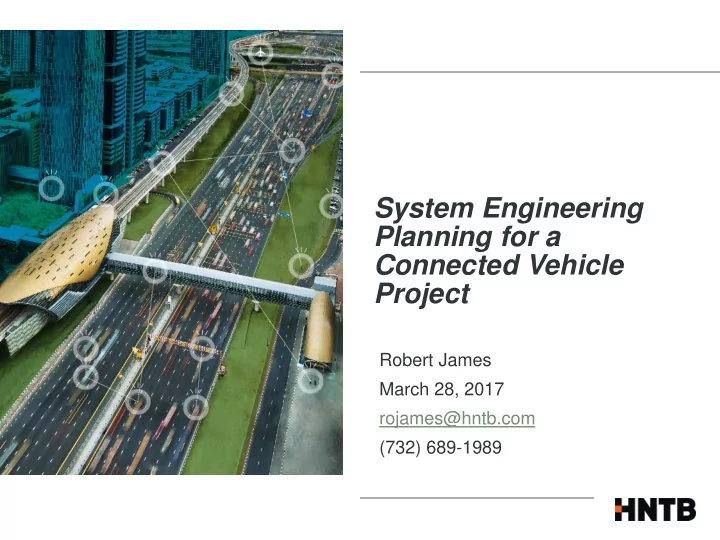

System Engineering Planning for a Connected Vehicle Project Robert James March 28, 2017 rojames@hntb.com (732) 689-1989
CONNECTED VEHICLES • Notice of proposed rulemaking on December 13, 2016 • Signal to automakers and government agencies • GM moving forward • Government stimulus for V2I – Connected Vehicle Pilot Deployment program – Smart City Challenge Source: USDOT – ATCMTD Program (FAST Act)
Connected Vehicles Connect Automated Vehicles • Highest Priority In USDOT’s Plans • NHTSA Rulemaking December that all new vehicles have to have CV in 5 years. Most Auto manufacturers are planning sooner. • 3 National CV Pilots and CV in Smart Cities • Dozens of Applications being developed with technology • Opens doors for BRT funding for Signal Priority Implementation $$$ • CAV first proposed 23 years ago • We are systems engineers for the Tampa CV Pilot, Columbus Ohio Smart Cities project and CAV Pilot in New York • Our Aviation has hopped in with CAV demonstrations to replace APMs 3
Federal Requirements • Federal requirements described in 23 CFR 940 mandate that systems engineering analysis be performed for all ITS systems deployed using Federal funds. • Many ASCT products are considered for proprietary purchase, which, when using Federal funds, requires justification in accordance with 23 CFR 635.411. • Proper systems engineering documentation provides such justification.
Connected Vehicle Feasibility and Evaluation • Identify the driving need for CV • Evaluate vendor products for application desired (Denso, Delphi, Veniam, Savari, Lear, Wave Mobile, etc.) • Evaluate other enabling technologies for application (UWB) • Model algorithms to be used on VisSim or other tools • Future Proof the deployments for other applications (SPaT, signal notification to vehicles, Basic Safety Message, vehicle warning, vehicle automation, etc.) • Coordination deployments with other agencies • Evaluate costs and funding sources $$
NJDOT Systems Engineering Document Overview
NJDOT Systems Engineering Review Form (SERF) • A “corridor - specific” document that addresses the operations, strategies and stakeholders of the proposed system. • Document is in a question/answer format A. Project Description B. Project Objective(s) C. Concept of Operations D. Verification and Validation Requirements E. Adaptive Recommendations F. Alternatives Considered G. Currently Available Adaptive Systems H. Appendices (I – VIII)
Concept of Operations Overview • Developed from a user perspective (stakeholder meetings) • High-level document that can be understood by a general audience • Intended to establish the functional and operational requirements and the Adaptive operational and support environments • Includes scenarios related to the project • Needs statements are attached as an appendix to the ConOps
Needs Statements • Needs are listed to identify how the System Engineering Requirements are to be met • Each needs statement should reference to the System Engineering Requirement where possible • The Needs Statements were revised significantly and both the System Engineering Requirements and the Validation Plan are dependent on them
System Requirements Overview • Intended for technical staff, system users, system designers, and vendors • Describes WHAT needs to be achieved by the system • It specifically does not describe HOW a system will satisfy needs • Made to be “procedural” and generic for application to all Adaptive projects
Connected Vehicles - SPaT Signal Priority Local Bus to Signal Approach Connected Vehicle (V2I) Traffic Signal Equipped DSRC Radio Connected Vehicle Applications · Pedestrian in Signalized Crosswalk Warning (Transit) · Intersection Movement Assist (IMA) · Left Turn Assist (LTA) · Vehicle Turning Right in Front of Bus Warning (Transit) · Eco-Approach and Departure at Signalized Intersections Bus with Connected Vehicle · Eco-Traffic Signal Timing Device · Eco-Traffic Signal Priority · Operations Communications This approach requires a DSRC radio installed in the vehicle and will work with DSRC Signal Priority and Timing (SPaT) Intersections. May need Ultra-wideband added to improve lane accuracy especially in urban canyon. Can do pedestrian detection as well.
Automated Transit Application of Connected/Automated Vehicles Vendor(s) Technology Application Benefits Lane Departure Warning Safety Mobileye Forward Collision Warning Deployed in 15M Headway Monitoring Warning Autos and 3500 Buses Pedestrian Collision Warning (Included in Wabco Speed Limit Indication product below.) Intelligent High Beam control Adaptive Cruise Control Safety/Capacity Wabco Lane Departure Warning Can equip MCI buses easily Automatic Emergency Braking Vehicle-to-Vehicle (V2V): Cooperative Adaptive Cruise Control, Electronic Emergency Brake Light (EEBL), Safety Connected Vehicle Forward Collision Warning (FCW) , Blind Spot Warning (BSW), Intersection Movement Assist (IMA), Lane Vendors Change Advisory (LCA), Left turn assist (LTA), Do Not Pass Warning (DNPW). Vehicle-to-Infrastructure (V2I): Mechanical health monitoring, Terminal Gate Assignment Notification, Mobility/ Can see if Digi Routers Terminal Fleet Management, Curve Speed Warning (CSW), Work Zone Warning (WZW), Spot Weather Operations can add DSRC radio, Impact Alerts , and Bus Signal Priority/in-vehicle SPaT (Signal Phase and Timing) visualization. Savari, Delphi, Wave Vehicle-to-Pedestrian or Vehicle-to-Phone Communication (V2P): Enables cars to identify pedestrians Safety Mobile, Denso, crossing streets in unpredictable situations and alerts the drivers through an application displayed either on a smartphone or on In-Vehicle-Infotainment systems Veniam, Lear Automated Merging Safety/Capacity Chinese company did a few in Oregon and Lane Centering/Lane keeping Assist California - Needs Automatic Terminal Control Operations development and steering actuation 13
Automated Transit Enabling Technologies
Automated Bus Options EmX Articulated Larger Bus – 30+ passengers Amsterdam Airport Mercedes-Benz Future Bus https://www.youtube.com/watch?v=oBjFT9WAQxU Eugene, Oregon EmX Articulated - https://www.youtube.com/watch?v=_oKsleOocFM Mini Buses – 12 passenger 2getthere Helsinki/Oslo/Tokyo - EZ-10 electric Mini Buses - GRT Mercedes https://www.youtube.com/watch?v=6ZTlqyQGmqQ Future Bus Local Motors/Intel’s Olli - https://www.youtube.com/watch?v=9joEsWiYFEI Ollie Netherlands ParkShuttle – 2getthere GRT - https://www.youtube.com/watch?v=WlAHXcQHWpU Greece/Spain CityMobile2 - https://www.youtube.com/watch?v=L99XJg0qRVc EZ-10 Personal Rapid Transit (PRT) – 4 Passengers London Heathrow POD Cars from Ultra Global https://www.youtube.com/watch?v=Byk8LcPovOQ Masdar City Abu Dabi – 2getthere PRT https://www.youtube.com/watch?v=5G9X0voSi2Y 2getthere PRT Ultra PRT
Recommend
More recommend